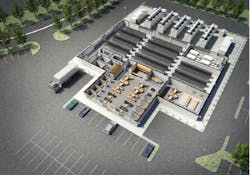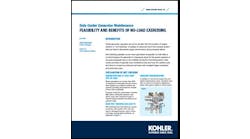Ten years ago, I started an Edge Data Center Company, Ubiquity Critical Environments, based on the premise that “The Edge” was a product and a place; a sub-1MW facility located in underserved Tier 3&4 Metropolitan Statistical Areas (MSAs), increasing in value over time vis-à-vis The Network Effect.
I partnered with Schneider Electric to design, build, and operate this new style of small, modular facility. I also partnered with the now defunct Sears Holdings Corporation and their 250MM sf. real estate portfolio for dirt and powered shells. It was one of the first forays into speculating the what, where, and when of the edge landscape.
Ubiquity is long gone and certainly forgotten, but having the opportunity to work alongside and witness the birth of some of the primogenitors in the edge space (Compass, EdgeConnex, DartPoints, Involta, Vapor IO, and others) was invaluable. Schumpeter’s Gale blew through the industry and creatively destroyed many preconceived notions of what data centers wanted to be when they grew up.
But I find it fascinating that over the course of these same ten years the majority of these founding edge companies have rapidly expanded the critical load capabilities of their offerings; edge facilities have gone multi-megawatt!
So even though I consider myself knowledgeable in the data center space, just like everyone else, I am challenged to define what exactly constitutes an edge data center these days. It’s seemingly ephemeral.
To understand this phenomenon, it’s helpful to remind ourselves what the edge is and the technological forces involved in its definition. Very simply, borrowing the original network architecture terms, the edge is the point farthest from the core. More tangibly, the edge is the device we all carry around in our pocket that originates, replicates, and transfers the volumes of data we are creating daily. So quite literally, we are living on the edge. According to Cisco’s Annual Internet Report, there are almost 27 billion connected devices on the planet today. Growing at a 10% CAGR, that means there will be more than 35 billion devices by 2025, all generating massive and accelerating amounts of ‘edge’ data.
All of this data needs to be stored and forwarded, so it’s no surprise that TechNavio assigns a 26% CAGR to the edge computing market, a big jump from the 19% that PwC has been using since 2019. McKinsey says 75% of enterprise-generated data will be processed by the edge or cloud by 2025 and IDC believes that by as soon as 2023, 50% of new IT infrastructure will be deployed at the edge.
Why the increased velocity? 10 years ago in the US, the average smartphone memory capacity hovered at around 20GB, home internet connections averaged a whopping 5Mbps of bandwidth, and robust public bandwidth was rare. Our digital infrastructure could not yet support our voracious appetite for data transfer. By creating the supply in recent years, ubiquitous deployment of high-speed 5G and public WiFi connectivity, we’ve actually created demand by enabling it.
Given this context of rapid techno-cultural data growth, it makes perfect sense, then, that our definition of “edge data center” continues to evolve and grow in concert with technological forces. The edge is no longer a specific size or as precise of a place, but just because it has grown more complex does not mean that we can’t distinguish what or where it is.
Awe-inspiring advances in technologies such as self-driving vehicles, the mass shift to a remote workforce, and low-latency imperatives like medical wearables have combined forces to usher in an accelerated timeline. The Edge is everywhere and continually changing. Take a look around right now as you’re reading this. Are you in your “Edge Office” at home? An airport? An airplane? Maybe, if you’re lucky, at a good ole’ fashioned company office surrounded by colleagues. When ideating for this article, I was hiking the woods behind my property in a late-March Wisconsin snow shower. As I crested the south ridgeline, I pulled out my phone to stream some video notes because at the top of that climb I know I can pull down the 5G signal from a tower a half a mile away. So despite being deep in nature, amongst the towering oaks and turkey tracks, I, like all of us now, was living on the edge.
Sean Farney is Director of Data Center Marketing at Kohler Power Systems. Contact Kohler to learn more about their data center solutions.





